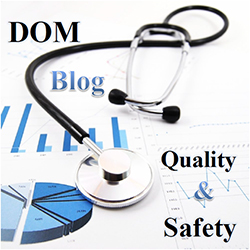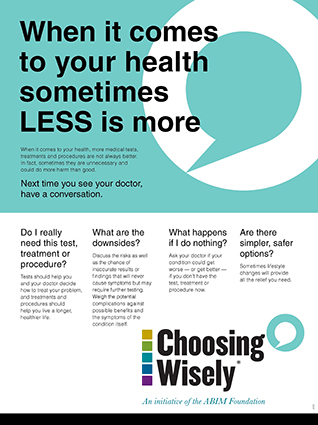A couple of weeks ago, I was rounding in the South Campus Intensive Care Unit where we had a patient with ACEI-induced angioedema. The gentleman developed facial swelling shortly after starting an ACE inhibitor (ACEI) that was prescribed for hypertension. It was his first-ever episode, there was no family history and he was improving with conservative management.
 What struck me about the case was that our team had ordered C4 and C1 inhibitor levels despite no prior history of angioedema. The tests were ordered contrary to published guidelines, in the wrong time frame, and without considering the rarity of C1q deficiency (associated with lupus or kidney disease). This patient had no health insurance to cover this $3,000 in tests that weren't going to influence his care. Historically, academic culture was such that nobody was criticized for ordering more tests than necessary, but we certainly have been critical for leaving out a test that a supervising physician felt was needed.
What struck me about the case was that our team had ordered C4 and C1 inhibitor levels despite no prior history of angioedema. The tests were ordered contrary to published guidelines, in the wrong time frame, and without considering the rarity of C1q deficiency (associated with lupus or kidney disease). This patient had no health insurance to cover this $3,000 in tests that weren't going to influence his care. Historically, academic culture was such that nobody was criticized for ordering more tests than necessary, but we certainly have been critical for leaving out a test that a supervising physician felt was needed.
The Institute of Medicine with the National Academies of Sciences estimates that about 30 percent of health care costs, or $750 billion dollars per year, are spent on unnecessary tests and procedures (1). High health care costs and less than ideal outcomes have caused our health care system to pivot to a new focus on achieving value from health care. Value infers that patients receive high-quality care at reasonable costs (Value = Quality/Cost). Achieving high-value requires that we strive to eliminate waste, improve patient safety and increase quality. Finding high-value from what we do requires that we evolve to a mindset where we appreciate that many patients are being harmed by over-testing and by the financial stress associated with funding their health care through higher deductibles and insurance premiums.
The more testing we do, the higher the number of potential false positive results from low-yield diagnostic tests and the greater the additional tests, anxiety, excess radiation exposure and unnecessary invasive procedures (2). To minimize harm to patients, evidence must guide physicians in their ordering behavior, not their personal preferences.
 Earlier this year, Eileen Moser, MD, and colleagues, on behalf of the Choosing Wisely Campaign—an initiative of the American Board of Internal Medicine (ABIM) Foundation to address waste in health care, published a simple idea in the Journal of Hospital Medicine (3). They reported the results of a simple study where they encouraged trainees to expand their daily progress notes to include a section on “Value.” Their study participants wrote their usual SOAP notes and then added a section that outlined the expected value of the testing they were proposing, producing a SOAP-V note. The SOAP-V model prompted the writer to consider the evidence that supports a test or treatment, the patient's preferences and values, and the financial cost of a test or treatment compared to alternatives. The study subjects were then expected to report their Value ideas during patient care rounds. Notably, half of the trainees in the study were “afraid” to discuss their impressions of the value of the testing and procedures they had ordered or considered.
Earlier this year, Eileen Moser, MD, and colleagues, on behalf of the Choosing Wisely Campaign—an initiative of the American Board of Internal Medicine (ABIM) Foundation to address waste in health care, published a simple idea in the Journal of Hospital Medicine (3). They reported the results of a simple study where they encouraged trainees to expand their daily progress notes to include a section on “Value.” Their study participants wrote their usual SOAP notes and then added a section that outlined the expected value of the testing they were proposing, producing a SOAP-V note. The SOAP-V model prompted the writer to consider the evidence that supports a test or treatment, the patient's preferences and values, and the financial cost of a test or treatment compared to alternatives. The study subjects were then expected to report their Value ideas during patient care rounds. Notably, half of the trainees in the study were “afraid” to discuss their impressions of the value of the testing and procedures they had ordered or considered.
Do we really need daily coags and LFTs and CXRs? Is there value in trying to figure out the cause of a community-acquired pneumonia? In the ICU, just because patients are very sick does that mean they need intensive testing. A couple of years ago Kox and Pickkers wrote a great editorial in JAMA Internal Medicine reminding us that, in the past 30 years, we have learned that, in much of critical care, doing less is associated with better outcomes—in other words, “less is more” (4).
For this blog entry, I would like to offer a challenge to our department. Let’s embrace high-value care by adding a short value section to our H&Ps and daily progress notes that discusses why we are or are not sending off tests, and lets push ourselves to at least briefly discuss the Value of the testing and procedures we do during rounds.
Writing and talking about value is the surest start to delivery of high-value care for our patients!
—Phil
- Institute of Medicine. The Healthcare Imperative: Lowering Costs and Improving Outcomes. Washington, DC: The National Academies
- Greenberg J. Over-testing: Why More Is Not Better. Am J Med. 2014; 127:362–363.
- Moser, EM. SOAP-V: Introducing a method to empower medical students to be change agents in bending the cost curve. J Hosp Med. 11(3):217-20, 2016.
- Kox, M. “Less Is More” in Critically Ill Patients – Not Too Intensive. JAMA Intern Med. 173(14):1369-1372, 2013.
P.S.: The American College of Physicians and the Alliance for Academic Internal Medicine have developed a high-value care curriculum and resources for educators and residents, including video case examples (available free at https://www.acponline.org/clinical-information/high-value-care).
FYI: ACEI = angiotensin-converting-enzyme inhibitor or ACE inhibitor; SOAP = Subjective Objective Assessment Plan; LFTs = liver function tests; CXRs = chest X-rays; and H&Ps = history and physical examinations


 Phillip H. Factor, DO, FCCP
Phillip H. Factor, DO, FCCP